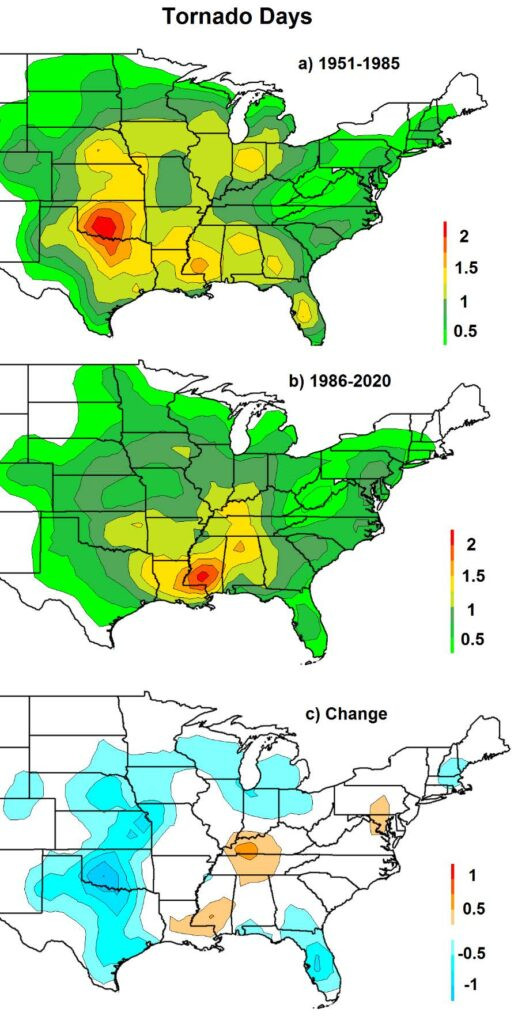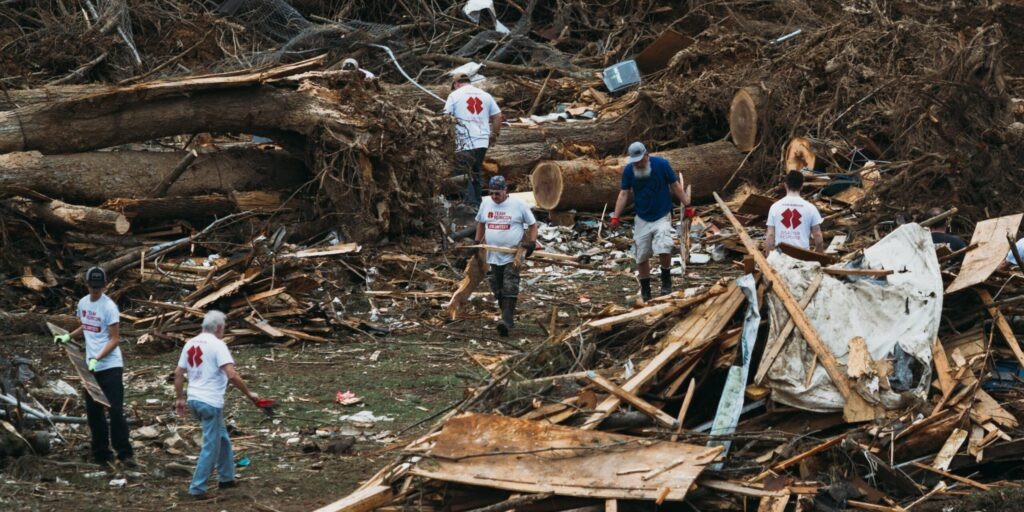Tornadoes stand as some of nature’s most formidable and frightening disasters, capable of unleashing winds up to 300 mph and traversing landscapes at speeds reaching 70 mph. These unpredictable storms can materialize seemingly at random, flipping vehicles, uprooting trees, demolishing buildings, and transforming ordinary debris into lethal projectiles.
These violent weather events originate within thunderclouds when warm, humid air ascends and clashes with descending cool air, subsequently encountering cool, rotating air near the ground. When these violently rotating air columns descend from thunderstorms without touching ground, they are termed funnel clouds. Upon ground contact, they officially become tornadoes.
While no community is entirely immune to the wrath of tornadoes, regardless of size, several devastating events serve as stark reminders of their indiscriminate nature. The 2019 Havana, Cuba, tornado, impacting a city of 2.13 million, resulted in eight fatalities. In 2020, Nashville, a city of 692,587, was struck, causing five deaths. More recently, in April 2024, Guangzhou, China, a sprawling metropolis of over 15 million, endured a tornado that damaged 140 structures and claimed five lives.
Tornadoes: A Global Phenomenon, Not Just an American Issue
Despite the common perception of tornadoes as a uniquely American phenomenon, particularly concentrated within the Great Plains, reports of these storms have emerged from every continent except Antarctica. While the United States holds the record for the highest documented tornado activity globally, this may be attributed to superior detection and reporting capabilities, primarily developed in the last three decades. Before the mid-1990s, an effective tornado detection system was absent, leading to unreported tornadoes and gaps in historical weather records, thus complicating long-term and global trend analysis. America’s advanced tornado detection systems rely on Doppler radar, which primarily indicates conducive weather conditions for tornado formation. Ground verification through damage assessment or eyewitness accounts remains crucial to confirm actual tornado occurrences.
This documentation challenge persists in rural regions of America and across the globe, resulting in incomplete tornado records and tentative conclusions. The possibility of tornadoes in Antarctica cannot be dismissed; their absence from records may simply reflect the continent’s sparse population and limited observation.
The deadliest tornado event ever documented occurred on April 26, 1989, in central Bangladesh. This catastrophic twister, with winds reaching 260 mph, carved a 10-mile path, obliterating two towns, causing approximately 1,300 fatalities, injuring 12,000, and leaving 80,000 homeless. Bangladesh has tragically experienced multiple high-fatality tornado events over the years, including five separate storms each causing over 500 deaths.
Asia, encompassing Bangladesh, Japan, the Philippines, India, and China, forms its own version of “tornado alley.” This region reports the highest frequency of tornadoes in Asia, along with a significant proportion of associated deaths, injuries, and damages, based on available data. However, the precise number of annual tornado occurrences remains unknown due to the absence of robust detection networks comparable to that of the United States in most of these countries.
South America also possesses a tornado-prone region, largely situated within the grasslands of Argentina and extending into Uruguay, Paraguay, and Brazil. While technically the second most tornado-active zone globally, averaging around 1,000 tornadoes annually, the damage caused is comparatively less severe, and tornado counts are likely underreported. The Southern Hemisphere as a whole reports significantly less tornado activity and related damage compared to the Northern Hemisphere. Australia and Africa collectively experience just over 100 tornadoes each year, with infrequent reports of mass casualties or widespread community damage.
Europe witnesses approximately one-fourth the number of tornadoes compared to the U.S., with most being relatively weak and causing minimal damage. However, they still result in an average of a dozen fatalities annually. Notably, the first reported tornado of 2024 struck Europe, causing damage to dozens of homes across a 4-kilometer stretch in Belgium on January 3.
The Shifting Sands of Tornado Alley in the U.S.
Research, corroborated by global news reports of tornado devastation, definitively demonstrates that tornadoes are not confined to the United States. Furthermore, the traditional association of tornadoes with America’s Great Plains states is becoming increasingly outdated. “Tornado Alley,” a colloquial term without precise scientific boundaries, traditionally encompassing states like Texas, Oklahoma, Kansas, Nebraska, and South Dakota, has been demonstrably shifting eastward over recent years.
 Graphic showing tornado alley us shifting east
Graphic showing tornado alley us shifting east
While over half of the 1,194 tornadoes recorded in the U.S. by June 14, 2024 occurred within the conventional Tornado Alley, numerous states outside this region have already experienced a higher tornado count in 2024 than typically seen in most Tornado Alley states. Ohio, for example, situated far from Tornado Alley, has recorded 71 tornadoes this year, surpassing the annual average of 69 tornadoes in Oklahoma, a state considered to be at the heart of Tornado Alley.
This eastward shift of Tornado Alley in the U.S. is supported by research published in the April 2024 issue of the Journal of Applied Meteorology and Climatology. The study indicates a discernible trend since 1951, with tornado activity migrating away from the Great Plains towards the Midwestern and Southeastern United States. While the exact causes of this shift remain under investigation, scientists point to increased atmospheric instability due to warming temperatures as a contributing factor. As a tornado expert from Environment and Climate Change Canada explained to Scientific American, “warming increases instability,” creating more favorable conditions for tornado formation in new areas.
And indeed, global warming is an undeniable reality, influencing weather patterns worldwide.
Southern States Bear the Brunt as Tornado Alley Evolves
Despite the eastward migration of Tornado Alley, historical data reveals that half of the deadliest tornadoes in America have occurred outside of this traditional zone, predominantly in the Southern states, according to the Storm Prediction Center.
This disproportionate impact in the South is likely due to a combination of factors. Southern states have denser tree cover, increasing the hazard of falling and wind-borne debris. They are also more densely populated and encompass numerous less affluent communities compared to the Great Plains. Research published in Nature highlights that the South “already represents a maximum in the occurrence of casualties associated with tornadoes.” The eastward and southward shift of Tornado Alley further exacerbates the risk of tornado-related damage and fatalities in this vulnerable region.
The heightened risk in the South underscores that disaster vulnerability is not solely determined by weather patterns but significantly influenced by economic resilience and community preparedness.
As emphasized by the director of the Atmospheric Sciences Program at the University of Georgia to Yale Climate Connections, the South exhibits a “high degree of social vulnerability,” encompassing significant Black, Hispanic, elderly, and impoverished communities. These communities possess heightened sensitivity to extreme weather events and diminished capacity for recovery. Therefore, the greater impact experienced in certain areas is not solely attributable to increased tornado exposure but also to a lack of resources for both disaster preparedness and recovery.
Jeff Byard, Vice President of Operations for Team Rubicon, aptly stated, “Tornadoes do not discriminate. Severe weather, including tornadoes, can impact every state, leaving a trail of destruction in its wake. The South is no stranger to the impacts that tornadoes create. Vulnerable communities often experience additional difficulties on their road to recovery. Those are the areas where you will find Team Rubicon, making a difference in the face of adversity.”
2024: A Record-Breaking Year for Tornado Activity
Even without considering the shifting Tornado Alley, tornadoes are more geographically widespread than commonly perceived. Furthermore, 2024 is shaping up to be a historically active year for tornadoes in America.
“This year has already seen over 1,000 tornado reports, the most active tornado season since 2017,” noted Team Rubicon Operations Manager Lia Wainwright.
The Storm Prediction Center documented 1,118 tornado reports through May 31, a stark contrast to the historical average of 606 tornadoes in the U.S. between January and May.
 graph of tornadoes
graph of tornadoes
As of June 14, the Southern states had experienced well over 100 tornadoes, with 90 occurring in Florida and Alabama alone. Iowa reported over 100 tornadoes, Illinois 67, and Wisconsin 27. Even California, not traditionally associated with tornadoes, recorded five tornadoes this year.
AccuWeather forecasts between 1,250 and 1,375 tornadoes across the United States in 2024, exceeding the historical annual average of 1,225 but slightly below the 1,423 reported in 2023. Researchers from the National Severe Storm Laboratory at NOAA indicate that while the average annual tornado count remains relatively stable, tornado outbreaks are becoming more frequent.
In essence, while tornado days—days with tornado occurrences—might be decreasing, when tornadoes do strike, they tend to occur in clusters and increasingly in regions outside the historically expected areas.
Navigating a Future with Shifting Tornado Patterns
While precise tornado forecasting remains a challenge, the potential consequences of a shifting Tornado Alley careening eastward are becoming clearer.
“Economic losses associated with tornadoes will continue to increase in future years,” cautioned research published in Nature. As Southern communities expand and infrastructure develops, the financial and human costs of these natural disasters are projected to rise, potentially tripling due to the pre-existing high social vulnerability index (SVI) in many communities across the region, as identified by the CDC.
 Volunteers among trees and debris in tornado alley US.
Volunteers among trees and debris in tornado alley US.
From Alabama to Bangladesh, tornadoes, like all disasters, disproportionately affect the most vulnerable populations. Robust infrastructure, well-defined community emergency plans, and economic stability are crucial for communities to build long-term resilience and implement effective short-term disaster responses. Organizations like Team Rubicon prioritize disaster response and preparedness efforts in communities lacking these critical elements, utilizing the SVI to strategically allocate resources.
Wainwright emphasizes, “Our guiding light as we decide where Team Rubicon should respond to is taking into consideration a community’s resources and ability to respond to their own challenges. In the words of the founder and first chief of the U.S. Forest Service, Gifford Pinochet, we must do ‘the greatest good of the greatest number in the long run’.”

